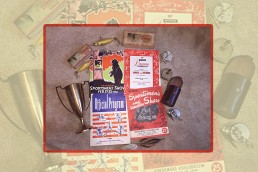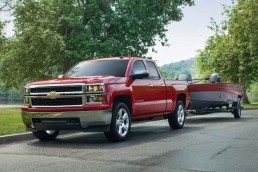On The Road Again!
SHARE THIS POST
Follow these smart towing tips to get you and your vehicles to your next destination safe and secure.
— Courtesy of Chevy Trucks
ON THE ROAD ACCELERATING/BRAKING
Avoid overworking your engine when trailering by applying gradual pressure on the accelerator. Allow your vehicle to safely reach a comfortable driving speed. Give yourself extra time and room when merging onto highways. Braking when pulling a trailer requires extra distance. Allow ample room to come to a safe stop. A good measure for determining a safe following distance is to allow one vehicle and trailer length between you and the vehicle ahead of you for every 10 mph of speed. When braking, use firm, steady pressure on the brake pedal.
CONTROLLING TRAILER SWAY
Sway refers to instability of the trailer relative to the tow vehicle, and often results from improper weight distribution, excessive speed or overloading. Other factors that can cause sway are crosswinds, poor vehicle maintenance and road conditions.  Trying to steer out of sway will likely make it worse. Speed is a major contributor to trailer sway, so you need to slow the vehicle — braking, however, could lead to a jackknife or other loss of control. To help control sway, follow these steps: • Hold the steering wheel as steady as possible • Release the accelerator but do not touch the brake pedal • Activate electric trailer brakes (if equipped) by hand, until the sway condition stops • Use the vehicle brakes to come to a complete stop You should pull your vehicle to the side of the road and attempt to determine the cause of the instability. Check the cargo load for shifting and improper weight distribution. Check tire pressure on the tow vehicle and trailer and the condition of the suspension and shocks. If the sway was caused by strong winds, wait for conditions to improve before continuing your trip. Finally, some trailers can be equipped with anti-sway devices. Contact the manufacturer of your trailer for availability.
Trying to steer out of sway will likely make it worse. Speed is a major contributor to trailer sway, so you need to slow the vehicle — braking, however, could lead to a jackknife or other loss of control. To help control sway, follow these steps: • Hold the steering wheel as steady as possible • Release the accelerator but do not touch the brake pedal • Activate electric trailer brakes (if equipped) by hand, until the sway condition stops • Use the vehicle brakes to come to a complete stop You should pull your vehicle to the side of the road and attempt to determine the cause of the instability. Check the cargo load for shifting and improper weight distribution. Check tire pressure on the tow vehicle and trailer and the condition of the suspension and shocks. If the sway was caused by strong winds, wait for conditions to improve before continuing your trip. Finally, some trailers can be equipped with anti-sway devices. Contact the manufacturer of your trailer for availability.
CORNERING
The turning radius of a trailer is typically much smaller than that of your vehicle; therefore, a trailer may hit soft shoulders, curbs, trees or other objects when making tight turns. Taking turns sharply can also cause the trailer to strike against and damage the tow vehicle. When approaching a sharp corner, brake sooner than normal to reduce vehicle speed before entering the turn. Drive the vehicle slightly past the normal turning point then firmly turn the steering wheel. By cornering at a wider angle, both the vehicle and trailer should safely clear the inside of the turn.
PASSING
When passing, allow additional time and distance to safely pass the other vehicle. Signal your intention to pass well in advance and, when reentering the lane after passing, make certain your trailer is clear of the vehicle you have passed. Never pass on hills or around curves.
Are you enjoying this post?
You can be among the first to get the latest info on where to go, what to use and how to use it!
BACKING UP
To back up a trailer, place one hand at the six o’clock position on the steering wheel. To move the trailer to the left, move your hand to the left. To move the trailer to the right, move your hand to the right. Back up slowly and move the steering wheel in small increments to help maintain control. To assist in backing up, it is helpful to have someone outside the vehicle to guide you. Make certain you can see your spotter at all times.
MWO
SHARE THIS POST
Did you enjoy this post?
You can be among the first to get the latest info on where to go, what to use and how to use it!
MWO
We believe being outdoors is good. With more than 1,000 articles each year, MidWest Outdoors magazine is all about sharing outdoor experiences with you—where to go, what to use and how to use it… whether you’re close to home or on that trip of a lifetime.



